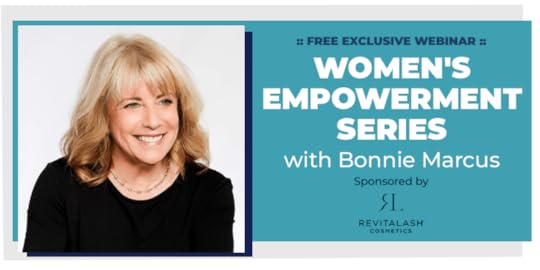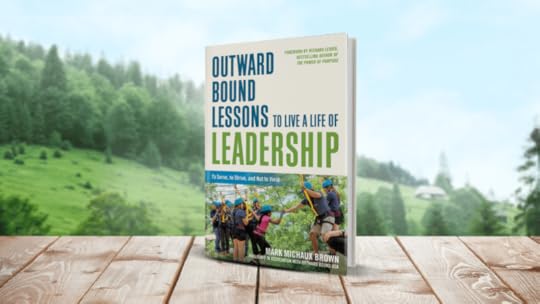Becky Robinson's Blog, page 25
November 14, 2019
Explore Expeditionary Leadership with Mark Brown

For nearly six decades, Outward Bound USA’s education programs have shaped the lives of tens of thousands of participants. Strangers are put in an unfamiliar and unpredictable setting, where to succeed they must develop a sense of teamwork, resilience, self-confidence, and a focus on the greater good. But isn’t the modern world just as unpredictable and challenging as any mountain or desert?
Mark Brown, author of Outward Bound Lessons to Live a Life of Leadership, explores the concept of Expeditionary Leadership through the stories of people such as third-generation business steward Laura Kohler, the Home Depot cofounder Arthur Blank, and former United States Senator Mark Udall, whose lives were touched by Outward Bound and who then went on to make a positive difference in the world. He shows how each of us can, in our own way, use the Outward Bound philosophy to bravely face the wild unknowns in our daily lives.
Watch below to learn how the principles that bind people together in the natural world work just as well in cities, companies, and communities. Explore how a leader’s growth and learning habits are reflected in their organization, and discover why expeditionary leadership is an excellent tool to use whether you are an entrepreneur or launching a company.
If you found this video helpful, you might also enjoy our upcoming webinar with Rich Brandt from RDR Group, as he explores how to become more resilient in work and life by taking ownership, regulating emotions, remaining optimistic, and leaning on others.
Most of us have hectic, stressful, high-pressure jobs. How do we keep from letting it get to us or burn us out? How do some people handle those challenges with confidence, poise, and grace? Join us on November 21 at 1 PM (ET) to discover the secret to overcoming obstacles and quickly adapting to change. Learn more and register here.
The post Explore Expeditionary Leadership with Mark Brown appeared first on Weaving Influence.
November 12, 2019
Don’t Forget the Marketing Collateral: People Like Stuff

Collateral — meaning printed brochures, rack cards, bookmarks, t-shirts, and more — has fallen a bit out of favor in this digital world. The up-front costs can seem high, and there is a limit to how many t-shirts you can give away. But consider this: one great t-shirt worn again and again can reach hundreds of thousands of people! And people will use your collateral because we all like stuff . . . especially free stuff.
The whole point of any marketing effort is to get your message in front of as many interested people as possible. The challenge is to develop something that people keep, reuse, and share so the message keeps circulating.
We work in the book marketing world, so we always suggest giving books away. I know it can sound counter-intuitive to give away the very books you are trying to sell; but as we’ve noted over the past eight years, the more of an author’s books we give away, the more they tend to sell. However, we’re not giving books away willy-nilly. We’re strategic with our efforts.
For instance, we might ignite a surprise-and-delight campaign with a client’s social audience or email list, giving everyone on the list who’s opened emails for the past five months an early, signed edition of a client’s book. Rewarding loyalty matters and it repays in kind.
Stuff People Love
We believe in giving away signed books, and to do that we often suggest book plates to clients. Book plates are essentially beautiful stickers with a great quote from the author, which can be signed in advance and added into books later. It turns any book into a signed edition, and makes the books feel very personal and special.
We also recommend bookmarks. Readers love bookmarks and tend to hold onto them. A beautiful design will stay with a reader and remind them of your books for a long time.
It can also be valuable (and fun) to create t-shirts or novelty products that bring the idea of your book to life. Think of the yellow LiveStrong bands that became a viral hit in the early 2000s. The investment was minimal, but the returns for LiveStrong were astronomical. You might not fund an organization on the backs of yellow bands, but you may create something that puts your message in front of a wider audience than you could have through digital outreach alone.
Or for another idea, I have a bag that I got at a trade show in the 1990s that I still use for every pool and beach trip. People stop and comment on the bag every time I use it, and the TV Land Network gets a little marketing bump.
Collateral works because we like novel, clever things that identify us with a brand, a lifestyle, or a tribe.
What can you create to bring your community together to share your message?
November 8, 2019
Building the Best: 8 Principles to Elevate Others to Success

Organizational culture has undergone a seismic shift in the 21st century–and with that, the requirements of leadership. In Building the Best, LearnLoft CEO John Eades takes you on a journey of transformation that will equip you with the tools you need to become the kind of cutting-edge leader today’s workplace urgently needs. Rethink what it means to be a leader today, and discover how to become a world-class leader who inspires, empowers, and serves—and who can transform the results of any team or organization.
Building the Best
“Leadership is about empowering, inspiring, and serving in order to elevate others over an extended period of time. You are the perfect person to live this out every day.” Eades’ powerful words form the backbone of this groundbreaking guide to cultivating leadership at its highest level.
Beginning with the benefits of great leadership―and the drawbacks of bad leadership―Eades offers real-life examples of leaders who elevate others, and how their practices have paid huge dividends. At its core is a carefully balanced blend of “love and discipline”―a guiding principle that helps create high levels of performance by leaning on standards while at the same time caring about the long-term success and well-being of each team member.
Through these proven practices, you’ll learn to:
• Identify your current leadership style
• Rely on the “purpose trifecta” to guide your team
• Be a leader who properly leverages the “Acts of Accountability” model
• Create a “Maximizing Mantra” to produce energy and results
• Develop the skills of others by understanding the “4 Stages of Role Development”
Leadership is a journey, not a destination. Building the Best offers a powerful blueprint for embarking on that journey―the first step in taking your team or organization toward true greatness.

Meet the Author
John Eades is the CEO of LearnLoft, an organization whose mission is to turn professionals into leaders and create healthier places to work. He was named a 2017 LinkedIn Top Voice in Management & Workplace, and his writing has reached over 7 million readers. He is also the author of Building the Best: 8 Proven Leadership Principles to Elevate Other to Success and host of the Follow My Lead Podcast.
As an award-winning motivational speaker, writer, and leadership development thought leader, he connects to the hearts and minds of leaders from all industries and experiences.
Praise from Readers Like You
“This book is the ultimate guide to a healthier organizational culture. If you want to build better leaders and develop cohesive teams, you need to study this book. Filled with real stories and actionable processes, this book will help you build better teams.” —Mareo McCracken, Amazon review
“The book is a tool that will empower you so that you can benefit from John’s experience and apply those learnings to be a better leader yourself. . . . [It] is packed with ideas, examples, and principles that are most applicable for front-line managers but can also be used by leaders in all walks of life.” —Leslie, Amazon review
“John Eades has written a concise, readable, and practical blueprint for leadership that goes beyond the leader, describing ways to elevate followers to be successful. Eades uses rich narrative and common sense, along with qualitative examples to demonstrate how leaders can empower their teams.” — Daryl Delabbio, Amazon review
Learn More
Buy the book on Amazon for yourself or a friend, or leave a short review of it.
Visit the website to learn more about the book and access pre-order bonuses.
Subscribe to the podcast for tips, tricks, and hacks from experts about leadership.
November 5, 2019
Let’s Have a Party: 5 Ideas to Launch Your Book

Who doesn’t love a party? Well, speaking as an introvert, perhaps not everyone enjoys a big get together — but there are plenty of ways to celebrate your book launch that will play to the comfort levels of everyone on your mailing list.
Over the years, we’ve seen authors celebrate in a variety of ways. Some clients went big — cakes in the shape of their book and free-flowing champagne — while others went with something smaller and more intimate.
We’ve helped authors host virtual gatherings on launch day, making the launch team feel more a part of the process; and we’ve also worked with authors who chose to celebrate the launch by leaving town and taking a family vacation, almost ignoring the release as they personally celebrate having everything behind them. Everyone is different!

Whatever you choose to do, the first step is to make a plan.
As you can see in the infographic to the right, there are a lot of decisions to make.
Online or in person? Hosted at your home or a local bookstore? Will you need to bring food or will the venue provide it? How much do you want to spend? If it’s online, do you have a Zoom account that will allow you to host a group? What kind of “party gifts” will you offer to your friends or online team? Are you going to do giveaways during an online event?
And that’s just for a start! There are a million little details that you could focus on, but the main thing here is to decide what makes the most sense for you, your supporters, and your calendar.
Launching a book is a big deal, and you want people to celebrate with you — but if your book launches on a Tuesday and it makes more sense to throw a party on Saturday afternoon, so be it!
Stuck for party ideas? Here are a few to get you started . . .
1. Bring a Friend
On the day of the release, host an exclusive, 30-minute webinar with your launch team, but give them the option of inviting a friend. As a party gift, let them know that everyone who brings a friend will receive a free electronic download of your book for them, AND one for their friend.
2. BOGO — Bring One Get One
If you’re hosting an in-person event, tell those you invite that if they show up with a copy of your book (or a receipt from Amazon showing that they ordered it), you’ll give them a signed second copy to give to a friend.
3. Coffee Chat
Maybe you’re not interested in hosting a full-on party, so keep it low-key. Using social media and your email list, let people know that you’ll be at a local coffee shop or bookstore on a specific date between the hours of 4-6, if they’d like to join you for coffee and talk about the book.
4. Launch Day Live
Use the ease of a Facebook Live to celebrate the book launch with your Facebook friends. Host a Q&A from the comfort of your own living room, or talk about your favorite sections of the book or the book launch process. Keep it informal and short. You could even pop in for 10 minutes, three times on launch day, to hit up friends in different time zones, and let people know when you get new reviews or hit a new high ranking on Amazon.
5. Instagram Story the Day
Start out launch day with a cup of coffee and your book, then move to your commute. Taking the train into the city or a plane to vacation? Share a story of you reading your book in those locations. Not sure how interesting your day really is? You might be surprised at what you could do. This couple does a really good job of sharing their travels and daily adventures using a mixture of photographs and videos.
Celebrating the launch of your book can be as big or as small a deal as you want to make it. But whether you choose the all-out bash, or you reward yourself quietly with a Venti Pumpkin Spice Latte, make sure you take a moment to breathe and realize what you have accomplished.
Well done, you!
Want to save this infographic for future reference? Bookmark this post, or right-click on the image to save to your computer!
November 1, 2019
Women, Step Into Your Power with Bonnie Marcus

These are challenging but changing times, and more than ever, women need to know how to position themselves at work. Many women focus on performance, thinking that good work garners promotion. Yet too often, unconscious bias and stereotypes create special challenges for women, and they’re left outside of the circles of power and influence where decisions are made that affect their careers.
Bonnie Marcus, president of Women’s Success Coaching and author of The Politics of Promotion, provides a framework for breaking into those circles and learning to navigate the complex rules and customs that hinder professional recognition for women. Her ongoing Women’s Empowerment Series offers the tools and guidance women need to successfully navigate the realities of their organization.
How to Step Into Your Power
In the first session of the Women’s Empowerment Series, Bonnie explained the subtle ways women give their power away — and how they can get it back. It’s no secret that society still isn’t comfortable with powerful women. And as ambitious women, we struggle to balance our desire to succeed and our need to be liked and accepted. As a result, we often give our power away.
Watch below to discover how we choose to use our power by unconsciously giving it away, consciously giving it away, or owning it. You will learn about the implications of the Doer trap, and be empowered to take control of your life and career!
Bonnie continues the Women’s Empowerment Series by considering how women can navigate a rapidly changing workplace. Watch the second installment below to learn how organizations can best support women in the workplace. Explore the idea of sponsorship of women by men, and consider how to effectively increase communication and interaction between men and women. You will gain a better understanding of the dynamics of office politics, and discover how women can use the tools in the political toolkit to become politically savvy!
Join Us Next Time
Join us for the next installment of the Women Empowerment Series on November 13, as Bonnie discusses how to develop personal authentic leadership. Discover how to best position yourself as a leader in a crowded field, and how to avoid some common traps that hold you back. This will be a valuable resource to anyone interested in self-development as a tool for leadership! Learn more & register here.
Women, Step Into Your Power!

These are challenging but changing times, and more than ever, women need to know how to position themselves at work. Many women focus on performance, thinking that good work garners promotion. Yet too often, unconscious bias and stereotypes create special challenges for women, and they’re left outside of the circles of power and influence where decisions are made that affect their careers.
Bonnie Marcus, president of Women’s Success Coaching and author of The Politics of Promotion, provides a framework for breaking into those circles and learning to navigate the complex rules and customs that hinder professional recognition for women. Her ongoing Women’s Empowerment Series offers the tools and guidance women need to successfully navigate the realities of their organization.
How to Step Into Your Power
In the first session of the Women’s Empowerment Series, Bonnie explained the subtle ways women give their power away — and how they can get it back. It’s no secret that society still isn’t comfortable with powerful women. And as ambitious women, we struggle to balance our desire to succeed and our need to be liked and accepted. As a result, we often give our power away.
Watch below to discover how we choose to use our power by unconsciously giving it away, consciously giving it away, or owning it. You will learn about the implications of the Doer trap, and be empowered to take control of your life and career!
Bonnie continues the Women’s Empowerment Series by considering how women can navigate a rapidly changing workplace. Watch the second installment below to learn how organizations can best support women in the workplace. Explore the idea of sponsorship of women by men, and consider how to effectively increase communication and interaction between men and women. You will gain a better understanding of the dynamics of office politics, and discover how women can use the tools in the political toolkit to become politically savvy!
Join Us Next Time
Join us for the next installment of the Women Empowerment Series on November 13, as Bonnie discusses how to develop personal authentic leadership. Discover how to best position yourself as a leader in a crowded field, and how to avoid some common traps that hold you back. This will be a valuable resource to anyone interested in self-development as a tool for leadership! Learn more & register here.
October 29, 2019
3 Ways to Celebrate Your Book Launch

You’ve written your manuscript, found a publisher, survived the revisions, and now you have a date circled on your calendar when your book will launch into the world. This is a big deal, and you need to celebrate it!
If you’re not sure where to start, we’ve got three ideas that you can take action on and personalize to fit your book and audience.
You’re Cordially Invited
I can always tell when one of my kids has received an invitation to a birthday party from a classmate, because as soon as they get in the car they’re talking about it and asking if they can go. They’re excited about the possibility of doing something fun, eating something good, and joining in their friend’s celebration. So why should a book launch be any different? Don’t you want people to be that excited with you about this major life event?
TAKE ACTION ⇒ We’ve talked about the importance of creating permission-based email lists in the past, and this is why. It’s time to reach out to those people who have opted in, and let them know that your book is coming and you’d like to invite them to help you celebrate. Don’t just make it another form letter, though . . . get creative! Start by asking yourself why people would want to support, buy, and promote your book over others in the same genre, and then share that with them.
Excitement is contagious, so if you’re excited, chances are, they will be too.
Don’t Be Afraid to Be The Center of Attention
Becky Robinson has been known to say that a book launch is like a wedding. Why? Because major life events such as a graduation, wedding, or retirement, usually involve a party, where your friends and family gather to celebrate with you. Reaching this milestone of becoming a published author should also be acknowledged and celebrated.
TAKE ACTION ⇒ This book that you’re about to publish is the culmination of months — if not years — of work, so don’t be shy about throwing some cake at it and inviting your friends to join you! Host the event at an independent bookstore, in your backyard, or at a local coffeehouse. Announce it through your social channels, and invite others to join you. The more the merrier! Set up a photobooth at the event, with copies of your book on hand (and your social handles clearly visible) so people can immediately take a snapshot and share their support of your hard work.
You’ve worked hard to get here, so don’t be afraid to shine!
Apply The Peppa Pig Principle
When my youngest turned five, she was right in the middle of a Peppa Pig phase. At her party we had Peppa Pig plates, napkins, cups, hats, and party horns, and when she received a giant stuffed Peppa Pig, no one had any doubts about her excitement. Well, guess what? You’ve written a BOOK — you should be as excited as a Peppa Pig crazy five year old!
TAKE ACTION ⇒ If people visit your website, Instagram, Facebook, or Twitter accounts, can they instantly tell that you’ve written a book and you are excited about it? Have you “decorated” your online world with beautiful graphics announcing the release? Can they easily find out when it’s coming or where they can pre-order it? If the answer is no, then one of the first things you need to do is visit a free site like Canva and work on your party decor! Update your social headers, create graphics using book endorsements or quotes and share them regularly, let people know that you . . . and others . . . are a fan of this book!
In a world full of bad news, give people something to get excited about.
October 25, 2019
3 Outward Bound Lessons to Spark Your Leadership Growth

Outward Bound Lessons to Live a Life of Leadership explores the concept of Expeditionary Leadership through the stories of former instructors and graduates of Outward Bound USA, and demonstrates how each of us can — in our own way — use the Outward Bound philosophy to bravely face the wild unknowns in our daily lives.
Here are few key thoughts from the book to help you embrace your role as a leader, whatever your current job title may be.
You Are Already A Leader
Mark has a few key points he focuses on in this book that follow the Outward Bound tagline — To Serve, To Strive, and Not to Yield.
To Serve: mission-driven work, serving the community, and following your path
To Strive: the leader as learner, the importance of continuing to learn throughout the journey, and the value of perseverance
Not to Yield: learning new areas of yourself you don’t know exist, and using that knowledge in your life
The Outward Bound motto, which is the the way the book is broken down, had significant impact on me. When I read the book, I started with the mindset that this is a leadership book, and I need to read it as if I were the leader of a business, or a teacher, or — for lack of better words — in a position of leadership in which I had a lot of people following me.
As I continued reading, I realized that each of these areas of the Outward Bound motto fit into the different leadership roles I play in my own life. The motto doesn’t require you to be in a high position of authority, but it applies to the areas of leadership that we often forget about. For me personally, it’s the leadership role of being a mom. In my family, I am a leader.
I quickly began to shift the lens in which I was reading the book from, and looked for ways to apply it to my everyday, ordinary life as a wife and mom.
To Serve: I was challenged to think about the mission of my role as a wife and a mom. What is it that I want to see my family achieving, and what is my role in that? How am I setting up my husband and daughter for success? What values am I living out and instilling in them? What can I be doing to care for them well so that they do the same for others?
To Strive: I was challenged to consider the opportunities to learn and grow that I have neglected. Being a leader, no matter how big or small the role might be, there is a constant learning curve in order to be the best leader one can possibly be. What can I be striving after to better my role as a wife and a mom? What resources are available to me that I am not taking advantage of? In what areas of my leadership role do I need to dig in a little bit deeper, especially when it gets difficult, and what do I learn from those experiences?
Not to Yield: This part of the Outward Bound motto probably impacted me the most. It was almost like receiving permission to explore my life. It reminded me that it is absolutely okay, and even beneficial to take time to do some self-reflection and learn about myself. The only limits I experience are the limits I put on myself, and this was almost like a statement of freedom, to say, “I will not stop here! I’m not yielding to anything, and I am going to learn all there is to know about myself, even the stuff that surprises me!”
Since then, I have been doing some more self-reflection, and I have even been challenging myself to some brainstorming sessions where I have been writing down things I am noticing or discovering about myself and then making a plan to bring some of those things to life, whether it is a new activity I want to try, an adventure I want to go on, or something about my character that I want to develop a bit more.
Leadership Is About People
“Empathy and action together form the true measure of distinction of an expeditionary leader.”
In order to be the best leader you can possibly be, you first have to care for people.
Empathy — not only feeling for someone, but placing yourself in their shoes to try and understand what they are feeling — is a form of compassion and service. When you are empathetic, you are serving an individual. Without empathy, you won’t build strong relationships with those you are leading, because they won’t ever feel that you are connecting with them as an individual.
When you pair empathy with action, you have a strong leader. Someone who seeks to understand those they are leading, makes a plan of action, and then executes that plan . . . now that is a powerful leader.
There’s Always Opportunity To Lead
“We can lead from where we are. We don’t need the title or position of leader. We just have to do what is right. Despite the risk. For ourselves. For each other.”
I am not the CEO of a large company, or a professor at a large university — but I am a wife, a mom, a friend, I am involved in church, I serve in my community, and there is always an opportunity to be a leader.
We tend to place the importance of a leader based on how many followers they have, but this quote made me realize that I am being a leader any time I make the choice to do the right thing. Anytime I am making a decision that will impact people beyond just myself. There is no “number requirement” to be a leader.
All of us are leaders in several areas of our lives; we have to embrace those roles, even if they don’t have a title!
If you read Outward Bound Lessons, what were some of your key takeaways?
If you haven’t read it yet, order your copy here!
October 22, 2019
The 10 Commandments for Writing Killer Articles

Every author needs to write and publish constantly—right? If we don’t… who are we? Will our skills crinkle up and disappear? Will our influence disappear from the interwebs altogether?
Articles are a great way to build your platform and reach new readers, but crafting your message and selling your message are two very different skill sets. Some writers can do both. Most can’t.
So maybe there’s another way to look at article writing. Maybe instead of trying to meet an arbitrary quota, we should start asking whether the reader can smell our desperation when we set out to write an article that “sells” our idea rather than something that matters. (Spoiler alert: it’s all about the reader.)
If you’re feeling the pressure (or desire) to write an article, think through these ten things first.
1. Why are you feeling the pressure?
Peer pressure?
To get up on a soapbox?
To test out an idea for a new book?
To answer a question you get frequently?
To build your platform?
To beef up your blog archives?
To impart a small nugget of wisdom?
Vague ennui?
None of these are necessarily bad reasons for writing an article. But consider that, depending on your expectations and your season of life, there may be even better ways to impart that idea.
Maybe it’s a strategic coffee invitation, so that you can process your idea verbally with immediate feedback. Maybe it’s a quick invitation for comment on LinkedIn. Or maybe you are just trying to stay disciplined about writing every day. (If that’s your goal, consider a tool like 750words.com instead… your blog doesn’t need to be a dumping ground for every passing thought.)
2. Who is your audience?
If the article is for a publication, how much of that publication have you read? The best pitches come from interacting organically with an outlet or community for a while. When you’ve had a subscription for years, you’ll have a much better idea of the topics it covers and the way it covers them.
Never, never write a boilerplate pitch to shop around to multiple outlets. Let me repeat this: never, never, sent boilerplate pitches!! No two publications have exactly the same audience (or the same editorial staff), so why would one pitch work for both of them?
If you’re writing for your own blog readers, this is much easier because you’ve probably been interacting for years. You may even know many of them by name—in fact, you may be able to predict their comments in your head before the post even goes live.
But you’ll still need to answer the following question:
3. What is the ask?
Put another way: when my reader finishes reading this, what specific actions am I hoping they’ll take?
Examples of your ‘ask’ might be something that directly benefits you:
Buying your book
Leaving a comment on the post sharing their own experience with the subject
Subscribing to your email list so they never miss another brilliant idea
Or it might be a behavior change that benefits society:
Reconsidering a previously held belief
Apologizing to someone
Doing more research on the subject
Shifting mindsets
Whatever the ask is, make sure it’s absolutely clear. Otherwise, you’ve just wasted your reader’s time.
4. What is the very best format for this article?
Maybe you blog pretty regularly, but have hit a plateau on traffic. Why not try writing an op-ed? Or pitching your favorite magazine or industry publication? Trying out a fresh format might take a little extra research, but breathe fresh air into your writerly sails. (Of course, if you can turn the whole thing into a listicle, do that whenever possible.)
5. Where is the best place to share your article?
Proceed with caution when cross-posting content to your social networks, since each of your online networks has a different purpose—and a different blend of people. (Remember the rule about writing for your audience?)
Here are some basic rules:
Twitter—for anyone who has followed your professional work or wants to interact with you
LinkedIn—for anyone you’ve worked with directly, or would like to work with
Facebook—for anyone who might appreciate keeping up with your work (in a limited way!)
Email list—for anyone who has specifically signed up to read more of your content
Instagram—for anyone who might want to be part of your community, see you speak in person, or buy your book
Once again: it’s all about the audience. Think about which of your followers would most appreciate seeing this article, where, and in what way. If an article you really love starts to take off—as in, racking up hundreds of hits and comments in its first few hours online—consider capitalizing on the momentum by paying for ads to boost it even more.
As you finish the process, consider adding a few finishing touches to your article:
6. Within the article, can you link (strategically) to other posts on your site, or to sites you admire?
This is good for your SEO (search engine optimization) and might get noticed on the other end by your author crush.
7. How readable is the article?
Check the Flesch-Kincaid reading level here. Most newspapers and websites aim for an 8th grade reading level, so favor short, clear sentences over long ones.
8. Does it have a nice, clicky headline?
They’ll never find your content if they don’t love your headline. Headline Analyzer from CoSchedule will analyze your headline grammar and keywords and give you a predictive rating for how the headline will perform.
9. Have I read it out loud?
Unless you have a professional editor proofreading every post, read that sucker out loud. It’s the best way to catch awkward phrasing and mistakes.
10. Have I gone on a “which” hunt?
As you read it out loud, kill all your passive verbs (which slow down your writing). Keep an eye out for any cliches, overused phrases, or unnecessary words, like “which” and “that.”
Your turn! What are some other questions you ask yourself before writing an article?
October 18, 2019
Outward Bound Lessons to Live a Life of Leadership

The principles that bind people together in the natural world work just as well in cities, companies, and communities. Nowhere is this seen more clearly than through Outward Bound USA’s education programs, which puts strangers in unfamiliar and unpredictable settings, where to succeed they must develop a sense of resilience, self-confidence, teamwork, and a focus on the greater good.
This week, we are honored to launch a book that describes in detail the principles of Outward Bound, told through the stories of former instructors and graduates who show how to apply them to create healthier, more effective teams, organizations, and communities.
Outward Bound Lessons
For nearly six decades, Outward Bound USA’s education programs have shaped the lives of tens of thousands of participants. Strangers are put in an unfamiliar and unpredictable setting, where to succeed they must develop a sense of teamwork, resilience, self-confidence, and a focus on the greater good. But, Mark Brown asks, isn’t the modern world just as unpredictable and challenging as any mountain or desert? He shows how the same principles that bind people together in the natural world work just as well in cities, companies, and communities.
This book explores the concept of Expeditionary Leadership through the stories of people such as third-generation business steward Laura Kohler, the Home Depot cofounder Arthur Blank, and former United States Senator Mark Udall, whose lives were touched by Outward Bound and who then went on to make a positive difference in the world. They show how each of us can, in our own way, use the Outward Bound philosophy to bravely face the wild unknowns in our daily lives.
From training the first Peace Corps volunteers to partnering with thousands of educational institutions and corporations, Outward Bound has helped build the self-confidence and character of participants who have gone on to live richer, more fulfilling, and successful lives. Outward Bound internationally operates in thirty-three countries and impacts nearly a quarter of a million people annually.
Meet the Author

Mark Brown, former participant and instructor in Outward Bound USA’s education programs, believes the modern world is just as unpredictable and challenging as any mountain or desert. He shows how the same principles that bind people together in the natural world work just as well in cities, companies, and communities.
Originally a native of Northeastern Ohio, Mark moved to Naples, Florida, where he worked as a writer and magazine editor. At the age of 25, he decided to attend a 23-day trip to an Outward Bound course in Utah. It was life changing. After taking a temporary job as a van driver for Outward Bound in Minnesota, he helped successfully search for and rescue a teenage boy that had become separated from the group. As a result, Outward Bound asked him to become an instructor ,which began a 22-year working relationship with the organization. He accrued over 1,000 days in the wilderness as an instructor.
Mark eventually relocated to Asheville, NC, and continued his work with the North Carolina Outward Bound School. He trained to be a professional coach and began designing some of the first corporate leadership development programs that Outward Bound offered, blending the wilderness with classroom training and organizational consulting. He also earned a master’s degree in business/entrepreneurship from Western Carolina University, and began serving as a transformational leadership consultant in a variety of industries.
Mark currently lives in Hawaii with his family, where he continues his work as a master coach, consultant and facilitator, helping people and organizations successfully navigate the rapid changes of our modern world. When he’s not working, you’ll most likely find him disappearing down a trail, fishing with his son, or paddling a canoe somewhere. The wilderness always calls!
Praise from Readers Like You
“Outward Bound Lessons is simple, direct, practical, and can be implemented in nearly any setting. The three points – To Serve, To Strive, and Not to Yield are well illustrated by the author with his own experiences and those of others who practice these principles.” —DocMyron, Amazon review
“This book really brings together the story of outward bound but throughout this you also experience many leadership principles as well. I love that this book encourages all of us to be a lifelong learner no matter what. . . . Anyone that wants to learn some solid leadership principles will leave reading this with great ideas for the future.” —Dad of Divas, Amazon review
“I like the term ‘Expeditionary Leader’ that’s used in the book because it suggests good leaders never stop learning and they never stop being a part of the adventure. The book is relatively short, contains real life examples, and unpacks the Outward Bound motto: ‘To serve, to strive, and not to yield.’ Divided into three sections, each point of the motto is expounded upon with real people examples.” —Lisa K, Amazon review
“This book is a call to discover the possibilities of serving, striving and not yielding in ourselves and to set our own sails ‘outward bound.’ Each chapter ends with reflection questions to help the reader reflect and apply the content.” —Leslie, Amazon review
Learn More
Visit Amazon to buy a copy of the book or leave a short review of it.
Visit the website to learn more about Mark and other expeditionary leaders.
Watch the recent webinar to learn more about expeditionary leadership.



